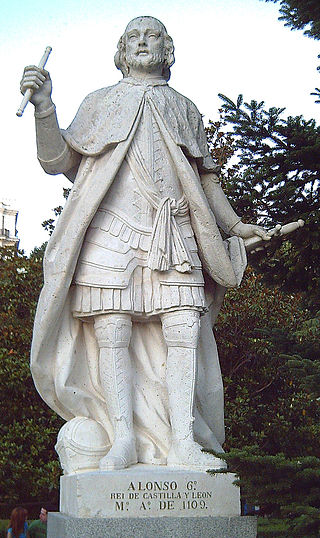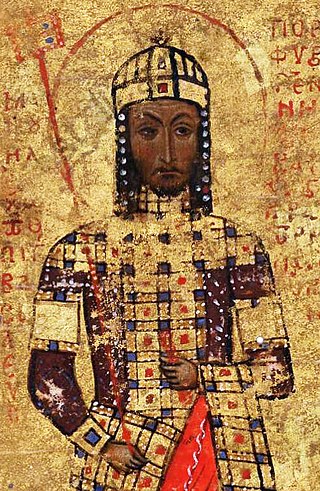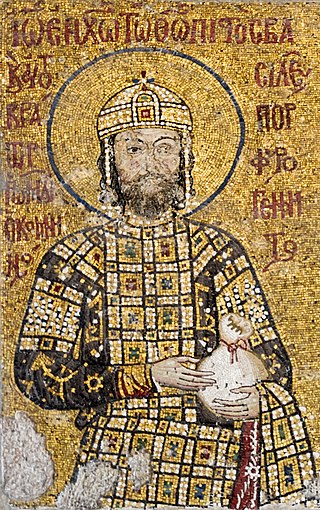Related Research Articles

Alexios I Komnenos, Latinized as Alexius I Comnenus, was Byzantine emperor from 1081 to 1118. Inheriting a collapsing empire and faced with constant warfare during his reign, Alexios was able to curb the Byzantine decline and begin the military, financial, and territorial recovery known as the Komnenian restoration. His appeals to Western Europe for help against the Seljuk Turks were the catalyst that sparked the First Crusade. Although he was not the first emperor of the Komnenian dynasty, it was during his reign that the Komnenos family came to full power and initiated a hereditary succession to the throne.

Year 1083 (MLXXXIII) was a common year starting on Sunday of the Julian calendar.

Manuel I Komnenos, Latinized as Comnenus, also called Porphyrogenitus, was a Byzantine emperor of the 12th century who reigned over a crucial turning point in the history of Byzantium and the Mediterranean. His reign saw the last flowering of the Komnenian restoration, during which the Byzantine Empire experienced a resurgence of military and economic power and enjoyed a cultural revival.

John II Komnenos or Comnenus was Byzantine emperor from 1118 to 1143. Also known as "John the Beautiful" or "John the Good", he was the eldest son of Emperor Alexios I Komnenos and Irene Doukaina and the second emperor to rule during the Komnenian restoration of the Byzantine Empire. As he was born to a reigning emperor, he had the status of a porphyrogennetos. John was a pious and dedicated monarch who was determined to undo the damage his empire had suffered following the Battle of Manzikert, half a century earlier.

The Fourth Crusade (1202–1204) was a Latin Christian armed expedition called by Pope Innocent III. The stated intent of the expedition was to recapture the Muslim-controlled city of Jerusalem, by first defeating the powerful Egyptian Ayyubid Sultanate. However, a sequence of economic and political events culminated in the Crusader army's 1202 siege of Zara and the 1204 sack of Constantinople, rather than the conquest of Egypt as originally planned. This led to the Partitio terrarum imperii Romaniae or the partition of the Byzantine Empire by the Crusaders and their Venetian allies leading to a period known as Frankokratia, or "Rule of the Franks" in Greek.

Baldwin II, also known as Baldwin of Courtenay, was the last Latin Emperor ruling from Constantinople.
Bohemond I of Antioch, also known as Bohemond of Taranto or Bohemond of Hauteville, was the prince of Taranto from 1089 to 1111 and the prince of Antioch from 1098 to 1111. He was a leader of the First Crusade, leading a contingent of Normans on the quest eastward. Knowledgeable about the Byzantine Empire through earlier campaigns with his father, he was the most experienced military leader of the crusade.
The Treaty of Deabolis was an agreement made in 1108 between Bohemond I of Antioch and Byzantine Emperor Alexios I Komnenos, in the wake of the First Crusade. It is named after the Byzantine fortress of Deabolis. Although the treaty was not immediately enforced, it was intended to make the Principality of Antioch a vassal state of the Byzantine Empire.

The Battle of Dyrrhachium took place on October 18, 1081 between the Byzantine Empire, led by the Emperor Alexios I Komnenos, and the Normans of southern Italy under Robert Guiscard, Duke of Apulia and Calabria. The battle was fought outside the city of Dyrrhachium, the major Byzantine stronghold in the western Balkans, and ended in a Norman victory.

The Alexiad is a medieval historical and biographical text written around the year 1148, by the Byzantine princess Anna Komnene, daughter of Emperor Alexios I Komnenos. It was written in a form of artificial Attic Greek. Anna described the political and military history of the Byzantine Empire during the reign of her father, thus providing a significant account on the Byzantium of the High Middle Ages. Among other topics, the Alexiad documents the Byzantine Empire's interaction with the Crusades and highlights the conflicting perceptions of the East and West in the early 12th century. It does not mention the schism of 1054 – a topic which is very common in contemporary writing. It documents firsthand the decline of Byzantine cultural influence in eastern and western Europe, particularly in the West's increasing involvement in its geographic sphere. The Alexiad was paraphrased in vernacular medieval Greek in mid-14th century to increase its readability, which testifies to the work's lasting interest.
Tatikios or Taticius was an Eastern Roman general of Turkish origin during the reign of Alexios I Komnenos. His name is also rendered as Tetigus, Tatizius, Tatitius, Tatic, or Tetig.

Constantine Doukas or Ducas was Byzantine junior emperor from 1074 to 1078, and again from 1081 to 1087. He was born to Emperor Michael VII Doukas and Empress Maria of Alania in about 1074, and elevated to junior emperor probably in the same year. He was junior emperor until 1078, when Michael VII was replaced by Nikephoros III Botaneiates. Because Constantine was not made junior emperor under Nikephoros III, his betrothal to Olympias, the daughter of Robert Guiscard, was broken, which Robert Guiscard used as a pretext to invade the Byzantine Empire. John Doukas forced Nikephoros to abdicate in favor of Alexios I Komnenos in 1081, and shortly afterwards Alexios elevated Constantine to junior emperor. Constantine married Alexios's daughter Anna Komnene, and remained junior emperor until 1087, when Alexios had a son, John II Komnenos. Constantine died in c. 1095.

The Komnenian restoration is the term used by historians to describe the military, financial, and territorial recovery of the Byzantine Empire under the Komnenian dynasty, from the accession of Alexios I Komnenos in 1081 to the death of Andronikos I Komnenos in 1185. At the onset of the reign of Alexios I, the empire was reeling from its defeat by the Seljuk Turks at the Battle of Manzikert in 1071. The empire was also being threatened by the Normans of Robert Guiscard, who were invading the Balkans from their base in southern Italy. All this occurred as the empire's military institution was in disarray and had grown increasingly reliant on mercenaries. Previous emperors had also squandered the large gold deposits of Constantinople, so the defense of the empire had broken down, and there were few troops to fill the gaps.

The Byzantine Empire was ruled by emperors of the Komnenos dynasty for a period of 104 years, from 1081 to about 1185. The Komnenian period comprises the reigns of five emperors, Alexios I, John II, Manuel I, Alexios II and Andronikos I. It was a period of sustained, though ultimately incomplete, restoration of the military, territorial, economic and political position of the Byzantine Empire.

The Byzantine–Norman wars were a series of military conflicts between the Normans and the Byzantine Empire fought from c. 1040 to 1186 involving the Norman-led Kingdom of Sicily in the west, and the Principality of Antioch in the Levant. The last of the Norman invasions, though having incurred disaster upon the Romans by sacking Thessalonica in 1185, was eventually driven out and vanquished by 1186.

The Byzantine Empire's history is generally periodised from late antiquity until the Fall of Constantinople in 1453 AD. From the 3rd to 6th centuries, the Greek East and Latin West of the Roman Empire gradually diverged, marked by Diocletian's formal partition of its administration in 285, the establishment of an eastern capital in Constantinople by Constantine I in 330, and the adoption of Christianity as the state religion under Theodosius I, with others such as Roman polytheism being proscribed. Under the reign of Heraclius, the Empire's military and administration were restructured and adopted Greek for official use instead of Latin. While there was an unbroken continuity in administration and other features of Roman society, historians have often distinguished the Byzantine epoch from earlier eras in Roman history for reasons including the imperial seat moving from Rome to Constantinople and the predominance of Greek instead of Latin.
Alexios Gidos was a senior Byzantine general of the late 12th century. He is the first attested member of the Gidos family, which rose to some prominence in the Byzantine Empire at the end of the 12th and the beginning of the 13th centuries.

The Byzantine Empire was ruled by emperors of the Doukas dynasty between 1059 and 1081. There are six emperors and co-emperors of this period: the dynasty's founder, Emperor Constantine X Doukas, his brother John Doukas, katepano and later Caesar, Romanos IV Diogenes, Constantine's son Michael VII Doukas, Michael's son and co-emperor Constantine Doukas, and finally Nikephoros III Botaneiates, who claimed descent from the Phokas family.
The Battle of Larissa was a military engagement between the armies of the Byzantine Empire and the Italo-Norman County of Apulia and Calabria. On 3 November 1082, the Normans besieged the city of Larissa. In July of the following year, Byzantine reinforcements attacked the blockading force, harassing it with mounted archers and spreading discord among its ranks through diplomatic techniques. The demoralized Normans were forced to break off the siege.
The timeline of the Latin Empire is a chronological list of events of the history of the Latin Empire—the crusader state that developed on the ruins of the Byzantine Empire after the Fourth Crusade in the 13th century.
References
- 1 2 Láiou, Angeliki E. (2001). The Crusades from the Perspective of Byzantium and the Muslim World Dumbarton Oaks Other Titles in Byzantine Studies. Dumbarton Oaks. p. 94. ISBN 9780884022770.
- ↑ Venning, Timothy; Harris, Jonathan (2006). A Chronology of the Byzantine Empire. Springer. p. 416. ISBN 9780230505865.
- ↑ Venning, Timothy; Frankopan, Peter (2015). A Chronology of the Crusades. Routledge. ISBN 9781317496434.
- ↑ Frankopan, Peter (2012). The First Crusade: The Call from the East. Harvard University Press. p. 149. ISBN 9780674064997.
- 1 2 "Petros Aliphas (Pierre d'Aulps) L XI / E XII". Prosography of the Byzantine World. Retrieved 10 January 2023.
- ↑ Talbot, Alice-Mary (1996). "Life of St. Theodora of Arta". Holy Women of Byzantium: Ten Saints' Lives in English Translation. Dumbarton Oaks. p. 327. ISBN 978-0-88402-248-0 . Retrieved 3 March 2024.